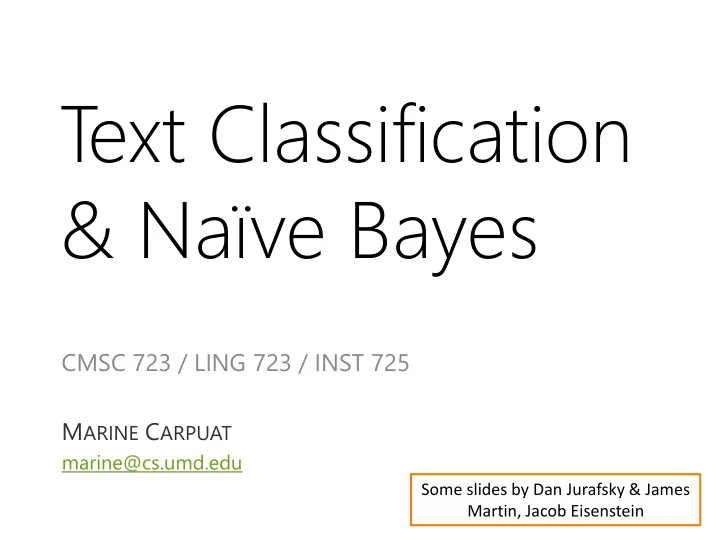

T ext Classification & Naïve Bayes CMSC 723 / LING 723 / INST 725 M ARINE C ARPUAT marine@cs.umd.edu Some slides by Dan Jurafsky & James Martin, Jacob Eisenstein
T oday • Text classification problems – and their evaluation • Linear classifiers Machine Learning, Probability – Features & Weights – Bag of words – Naïve Bayes Linguistics
TE TEXT T CLAS ASSIFIC SIFICATIO TION
Is this spam? From: " Fabian Starr“ <Patrick_Freeman@pamietaniepeerelu.pl> Subject: Hey! Sofware for the funny prices! Get the great discounts on popular software today for PC and Macintosh http://iiled.org/Cj4Lmx 70-90% Discounts from retail price!!! All sofware is instantly available to download - No Need Wait!
Who wrote which Federalist papers? • 1787-8: anonymous essays try to convince New York to ratify U.S Constitution: Jay, Madison, Hamilton. • Authorship of 12 of the letters in dispute • 1963: solved by Mosteller and Wallace using Bayesian methods James Madison Alexander Hamilton
Positive or negative movie review? • unbelievably disappointing • Full of zany characters and richly applied satire, and some great plot twists • this is the greatest screwball comedy ever filmed • It was pathetic. The worst part about it was the boxing scenes.
What is the subject of this article? MeSH Subject Category Hierarchy MEDLINE Article • Antogonists and Inhibitors • Blood Supply ? • Chemistry • Drug Therapy • Embryology • Epidemiology • …
T ext Classification • Assigning subject categories, topics, or genres • Spam detection • Authorship identification • Age/gender identification • Language Identification • Sentiment analysis • …
T ext Classification: definition • Input : – a document w – a fixed set of classes Y = { y 1 , y 2 ,…, y J } • Output : a predicted class y Y
Classification Methods: Hand-coded rules • Rules based on combinations of words or other features – spam: black-list- address OR (“dollars” AND “have been selected”) • Accuracy can be high – If rules carefully refined by expert • But building and maintaining these rules is expensive
Classification Methods: Supervised Machine Learning • Input – a document w – a fixed set of classes Y = { y 1 , y 2 ,…, y J } – A training set of m hand-labeled documents (w 1 ,y 1 ),....,(w m ,y m ) • Output – a learned classifier w y
Aside: getting examples for supervised learning • Human annotation – By experts or non-experts (crowdsourcing) – Found data • Truth vs. gold standard • How do we know how good a classifier is? – Accuracy on held out data
Aside: evaluating classifiers • How do we know how good a classifier is? – Compare classifier predictions with human annotation – On held out test examples – Evaluation metrics: accuracy, precision, recall
The 2-by-2 contingency table correct not correct selected tp fp not selected fn tn
Precision and recall • Precision : % of selected items that are correct Recall : % of correct items that are selected correct not correct selected tp fp not selected fn tn
A combined measure: F • A combined measure that assesses the P/R tradeoff is F measure (weighted harmonic mean): b + PR 2 1 ( 1 ) = = F b + P R 1 1 2 a + - a ( 1 ) P R • People usually use balanced F1 measure i.e., with = 1 (that is, = ½): – F = 2 PR /( P + R )
LINE NEAR AR CLAS ASSIFIERS SIFIERS
Bag of words
Defining features
Linear classification
Linear Models for Classification Feature function representation Weights
How can we learn weights? • By hand • Probability – Today: Naïve Bayes • Discriminative training – e.g., perceptron, support vector machines
Generative Story for Multinomial Naïve Bayes • A hypothetical stochastic process describing how training examples are generated
Prediction with Naïve Bayes
Parameter Estimation • “count and normalize” • Parameters of a multinomial distribution – Relative frequency estimator – Formally: this is the maximum likelihood estimate • See CIML for derivation
Smoothing
Naïve Bayes recap
T oday • Text classification problems – and their evaluation • Linear classifiers Machine Learning, Probability – Features & Weights – Bag of words – Naïve Bayes Linguistics
Recommend
More recommend